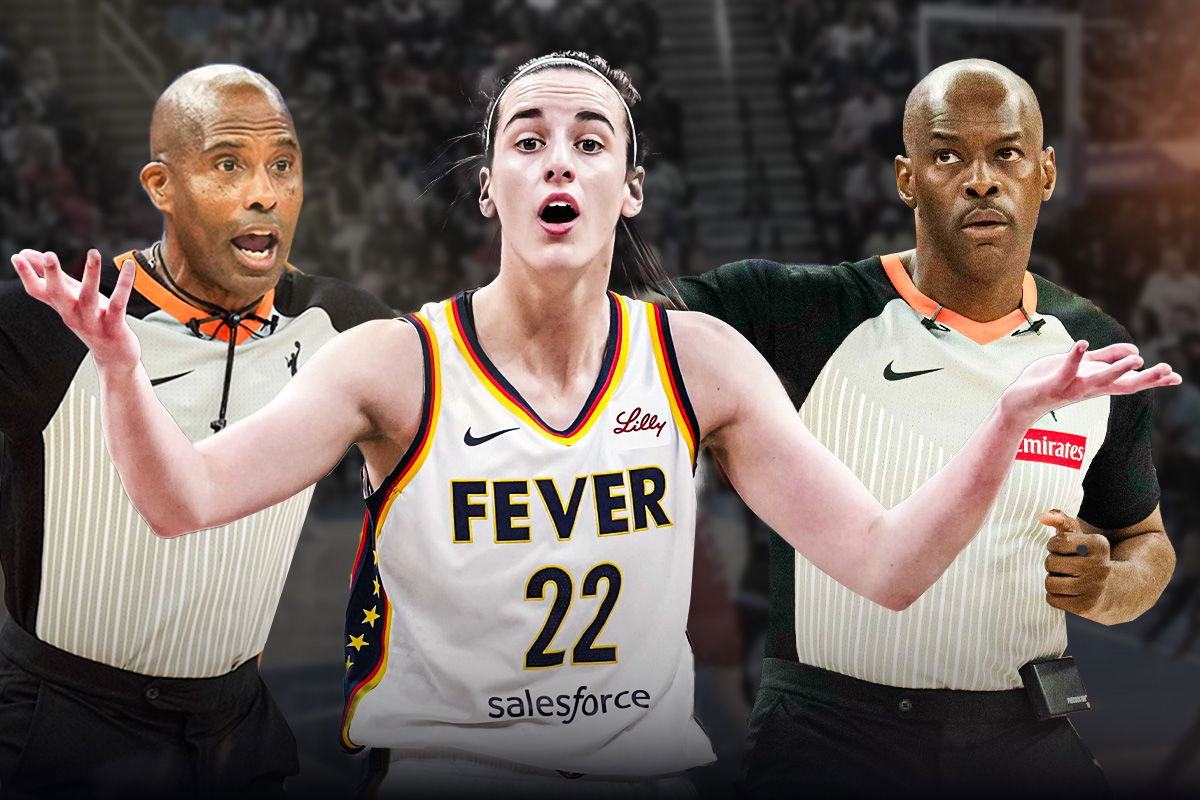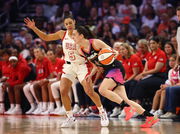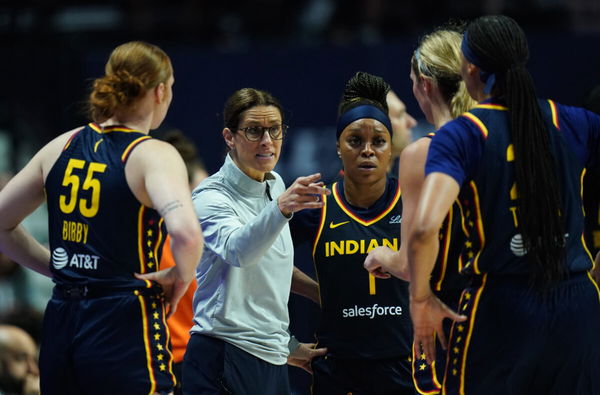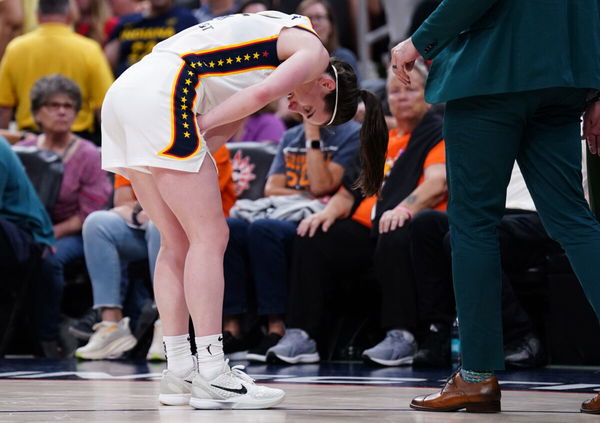
Imago
Credits : Imagn

Imago
Credits : Imagn
“I had hoped to share a better update, but I will not be returning to play this season……”
Watch What’s Trending Now!
With an Instagram post, Caitlin Clark confirmed the news no Fever fan wanted to hear, even if the writing was on the wall.
That fall on July 15 changed everything, derailing not just Indiana’s plans but also part of the WNBA’s spotlight season. After missing 19 straight games with a stubborn groin injury and making multiple comeback attempts, she made the difficult decision to shut things down. Her second year was over before it ever truly had the chance to begin.
ADVERTISEMENT
And what makes it sting even more is Clark’s history—she hadn’t missed a single game in four years at Iowa, nor during her rookie WNBA season in 2024. 183 consecutive games without interruption.
Now, suddenly, injuries were writing the story for her. Three separate setbacks, three attempted comebacks, and barely five games played each time before the pain returned. Clark has always known her body and trusted it, so if not her, then who really failed her?
Fans argue it wasn’t just bad luck, but bad officiating, that cut Clark’s season short.
ADVERTISEMENT
This was supposed to be the year she stepped fully into MVP conversations, and the stage was set, too. Clark’s passion for the game has never been in question. Everyone knows the fire she plays with, and yes, that same fire sometimes pushes her beyond the edge.
Last season, CC piled up six technical fouls, just one shy of suspension, but most stemmed not from rough play, but from her frustration when calls didn’t come. As her former associate head coach, now Iowa’s head coach, Jan Jensen, once put it, “She always kind of had that little attitude.” That edge is part of what fuels her, yet in a league where she often absorbed more hits than whistles, it raises the question: Did that attitude cost her calls and, in turn, help limit her to just 13 games this season?
ADVERTISEMENT
We may never know for certain, but what’s clear is that there were plenty of moments where Clark and the officials weren’t seeing the same game.
The preseason that set the stage for Caitlin Clark’s tumultuous season…
The Fever traveled to Atlanta, hoping to wrap up the preseason undefeated. But in a story that’s become all too familiar, Caitlin Clark picked up her first technical foul of 2025. So much for flashing the peace sign during the Bird & Taurasi show and claiming, “I already told Steph, two max,” when asked how many technicals she expected this season—turns out, reality had other plans.
ADVERTISEMENT
Caitlin had to be pulled away from the refs by Sophie Cunningham, and cameras even caught her muttering, “No one cares. No one cares,” after the technical. And honestly, she had every reason to be frustrated. The whistle came in the second quarter on a play where she felt a foul should’ve been called on a bounce pass that Atlanta’s Bri Jones intercepted and turned into a layup. In exasperation, Clark slammed the ball off the stanchion—and that was all the ref needed to hand her a technical.
This season, the margin for error was razor-thin, but that makes sense only when the calls were consistent. By the third quarter, Rhyne Howard barreled into Clark, sending her crashing to the floor. No whistle. No foul. Nothing. It wasn’t an isolated incident either…
Top Stories
Tom Brady Makes Career Announcement for Vegas as Pete Carroll Addresses Losing Raiders Locker Room

Cam Newton Makes NFL Return Conditions Clear to 32 Teams as Panthers Legend Confirms Retirement Stance

Scottie Scheffler Makes Critical Health Announcement After He Ended PGA Tour Hiatus

Andy Reid Makes Final Decision on Signing New Chiefs QB After Patrick Mahomes’ ACL Injury

Caitlin Clark Shows Concerning Signs vs. Kelsey Plum During USA Camp Debut, per National Reporter

Dolphins’ Jordyn Brooks Publicly Calls Out Locker Room Over ‘Poor’ Performance Against Steelers

Just a game earlier, in her return from a leg injury against Brazil’s national team, Clark absorbed heavy contact, possession after possession—yet the officials stayed silent. And in a way, those moments set the tone for what was to come in Clark’s season.
ADVERTISEMENT
Did Caitlin Clark or the officials’ mistakes cost the Fever?
In their fourth game of the season against the Liberty, the Indy side sat at 2-1 and were desperate to push their record to 3-1. With the clock winding down, they had one last shot to tie or steal the win. The ball was inbounded to Clark, who managed to get a shot off despite being clearly bumped by Natasha Cloud with just 1.2 seconds left. No whistle. No call.
Even broadcaster Debbie Antonelli noted on-air that Natasha Cloud was “all over Caitlin Clark”. The Liberty won 90-88, but Fever head coach Stephanie White didn’t hold back afterward:
ADVERTISEMENT
“I thought she got fouled. I think it’s pretty egregious what’s been happening to us these last few games”

Imago
Aug 17, 2025; Uncasville, Connecticut, USA; Indiana Fever head coach Stephanie White talks with her players from the sideline as they take on the Connecticut Sun at Mohegan Sun Arena. Mandatory Credit: David Butler II-Imagn Images
While many sided with White, seeing yet another instance of Clark being denied a fair whistle, others argued that Cloud was well within her rights to contest the shot. But regardless of how you viewed that final play, what came next was far more alarming.
ADVERTISEMENT
Shortly after the Liberty game, the Fever announced that Clark had suffered a left quadriceps strain—the first injury of her pro career. The setback kept her sidelined for more than two weeks, forcing her to miss five consecutive games and abruptly halting the momentum she had been building. Onto the next instance.
Drama Unfolds at Gainbridge Fieldhouse…
In only her second game back from injury, Caitlin Clark was quickly reminded of just how physical the WNBA could be:
ADVERTISEMENT
| Late in the third quarter, with 4:55 remaining, she was handling the ball on the perimeter when Jacy Sheldon made contact with her face |
| As Clark attempted to drive to the paint, Sheldon stayed glued to her, leaving no room to maneuver |
| The whistle finally blew just as the broadcast crew was commenting on the unusually rough play |
| Jacy Sheldon had poked Caitlin Clark in the eye from behind and appeared to taunt her, pushing the Fever star to her limit… |
| Frustrated, Clark shoved her away—and from that moment, what would become the infamous on-court fight began, a moment still talked about to this day |
Marina Mabrey jumped into the fray and confronted Caitlin Clark before Tina Charles and the Fever players stepped in to break it up. After what felt like forever, the officials finally reviewed the incident. The outcome?
Sheldon received a flagrant foul, while Clark and Charles picked up double technicals. Neither Marina nor Sheldon was ejected, mind you…
Status alert: Caitlin Clark, Marina Mabrey, Tina Charles assessed technical fouls Tuesday.
Jacy Sheldon was assessed a flagrant 1 foul.
No players were ejected.pic.twitter.com/YlBf7s39Hn
— Underdog WNBA (@UnderdogWNBA) June 18, 2025
In response to the chaos on the court, Sophie Cunningham made her stance crystal clear. Later in the game, she clashed with Jacy Sheldon, which also drew in Lindsay Allen, resulting in all three being ejected. After the game, Cunningham didn’t hold back, sending a clear message about player safety and accountability.
“During that, it was just part of the game,… I think the refs had a lot to do with that. It was a build-up for a couple years now of them just not protecting the star player of the WNBA. At the end of the day, I’m going to protect my teammates. That’s what I do, and I’m a team player.”
However, this fiery rivalry between the Fever and the Connecticut Sun was just getting started…
The Teary-Eyed Exit…
The fury of June 17 hadn’t faded away yet.
By July 15, both teams returned to the court charged and hungry. In front of 19,156 fans at TD Garden, Caitlin Clark struggled from beyond the arc. Every possession felt like a deep struggle, as the Sun’s relentless physical defense tested her at every turn, yet the whistles never came, leaving Clark and the crowd simmering in frustration.
By the third quarter, Clark’s frustration was impossible to hide! A video captured her being held back by assistant coach Briann January as she tried to confront a referee, while her brother tweeted, “Make no mistakes, this is one the reffing,” a post that has since been deleted.
The tension in the arena was palpable, as fans and teammates alike watched the fire inside her collide with the limits of the game. Then came the cruelest blow…

Imago
Jul 15, 2025; Boston, Massachusetts, USA; Indiana Fever guard Caitlin Clark (22) reacts with a possible injury after a play against the Connecticut Sun in the second half at TD Garden. Mandatory Credit: David Butler II-Imagn Images
Clark had to leave the court in tears after aggravating her lingering groin injury. Since that day, she hasn’t stepped back on a WNBA floor, leaving fans, teammates, and the league alike waiting, counting down the days for her triumphant return next season.
EssentiallySports’ verdict
Are the officials to blame for players getting injured? Not entirely. Basketball is a contact sport, and when you’re pushing the same muscles day in and day out, fatigue is inevitable. But that only tells one part of the story. With the introduction of the Golden State Valkyries, teams were suddenly forced to cram four extra games into the same stretch, piling on even more physical and mental strain.
With five more franchises expected by 2030, the number of games is only set to climb. Whether the WNBA will expand its schedule, potentially overlapping with the NBA, NFL, or other major American sports, remains uncertain.
If it doesn’t, the risk of injuries is almost certain to rise. The responsibility now falls squarely on the WNBA and the WNBPA to find a solution, whether that means larger rosters, a longer season, or both, to ensure players can handle the added load safely.
Yes, WNBA referees are paid far less than their NBA counterparts, so it’s no surprise that the men’s league attracts more experienced officials. But the refs are the ones who aren’t escalating situations once flagrant or technical fouls are called. Mistakes happen, and inexperience can play a role, yet there’s only so much they can do to prevent players from getting hurt on the court.
Do you think WNBA referees bear any responsibility for players getting injured? Share your thoughts in the comments.
We want to hear from you!
ADVERTISEMENT
ADVERTISEMENT
ADVERTISEMENT

